-
€

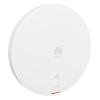
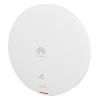
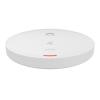
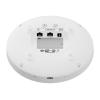




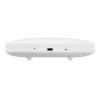
The Huawei AP661 is an access point from the eKitEngine series supporting the Wi-Fi 6 standard. It supports IEEE 802.11 b/g/n/ax protocols in the 2.4 GHz band and IEEE 802.11 a/n/ac protocols in the 5 GHz band. In the 2.4 GHz band, it operates with a single 2x2 MIMO transmission, and in the 5 GHz band, it operates with two transmissions: 2x2 MIMO and 4x4 MIMO. The maximum theoretical combined throughput is 6600 Mb/s. The device supports MU-MIMO (simultaneous transmission and reception of data from multiple users) and BSS coloring (transmission identification to reduce interference). The access point features a Smart antenna, which consists of multiple elements that can work independently. Depending on the needs, antenna elements can modify the shape of the main beam and adapt to connected clients. The AP661 is designed for locations with many users and can handle multiple connected client devices without network performance degradation. The enclosure is suitable for wall, ceiling, or T-rail groove mounting. The device has 1 2.5G Ethernet port (10/100/1000/2500 Mb/s) and 1 gigabit Ethernet port (10/100/1000 Mb/s). Power can be supplied using PoE in the 802.3at standard or through a DC socket (12 V).
The offered product can operate in several modes: Fat AP, Leader AP, Fit AP, or Cloud. In Fat AP mode, the device functions independently, allowing you to configure it like a regular wireless router. Leader AP mode allows you to configure the AP661 as a master device (leader) for managing other compatible access points. Cloud mode enables connecting the device to a cloud-based controller, while Fit AP mode is used to connect to another physical WLAN AC controller. Solutions from the eKitEngine series will enable you to create an extensive and efficient wireless network that can cover very large areas. The devices support data roaming, bandwidth control, and multiple authentication methods. AP661 is ideally suited for locations where potentially many users may be present, such as conference rooms, concert halls, or exhibition halls.
Wi-Fi 6 AX6600 wireless netwrok, Bluetooth
The AP661 is designed to transmit Wi-Fi 6 wireless networks, supporting IEEE 802.11 b/g/n/ax protocols in the 2.4 GHz band and IEEE 802.11 a/n/ac/ax protocols in the 5 GHz band. The device can simultaneously conduct 3 radio transmissions: 2.4 GHz 2x2 MIMO, 5 GHz 2x2 MIMO, and 5 GHz 4x4 MIMO - 2 + 2 + 4. Consequently, the maximum theoretical throughput is 574 Mb/s in 2.4 GHz, 1201 Mb/s in 5 GHz 2x2 MIMO, and 4804 Mb/s in 5 GHz 4x4 MIMO. Such high speed is particularly suitable for locations intended for multiple users simultaneously. The AP661 will provide sufficient throughput in situations where standard APs would not be able to deliver transmissions to clients at a fast enough speed.
The access point also utilizes several additional features that positively impact network quality. MU-MIMO allows simultaneous transmission and reception of data from multiple clients, eliminating data queuing. Beamforming shapes the beam to improve connection with devices at the edge of the coverage area, while TWT (Target Wake Time) conserves energy by waking connected devices only when a transmission is initiated.
Additionally, the device supports Bluetooth transmission (BLE 5.2), which you can utilize for remote management, localization, or IoT applications, among others.


2.5G Ethernet port, 1G Ethernet port, USB port, PoE / DC in
The offered product is equipped with one 2.5G Ethernet port (10/100/1000/2500 Mb/s) and one gigabit Ethernet port (10/100/1000 Mb/s). The 2.5G port also serves as the input for IEEE 802.3at PoE power, and power can also be supplied through a standard DC socket (12 V). The maximum power consumption, excluding USB, is 21.2 W.
The manufacturer has included a USB port with the intention of using it to connect an external modem for IoT support, such as ZigBee or RFID.
Smart antennas
The access point features Smart antennas, consisting of multiple elements that can work independently. Depending on the requirements, antenna elements can modify the shape of the main beam to provide the best coverage to connected clients. The device adapts to radio conditions and provides significantly better signal coverage than APs equipped with standard omnidirectional antennas. The gain is 4 dBi in the 2.4 GHz band and 5 dBi in the 5 GHz band.


Up to 1536 clients
The Huawei AP661 can support up to 1536 clients (512 per radio) and is designed for very challenging locations, such as exhibition halls or concert venues. The manufacturer suggests that the access point should ideally serve a maximum of 300 clients simultaneously. In this configuration, it can deliver approximately 22 Mb/s throughput to each client, which is sufficient for standard internet usage. The system supports load balancing and smart roaming, so if one access point becomes overloaded, users are switched to others.
The DFA (Dynamic Frequency Allocation) algorithm is used for automatically detecting wireless channel usage and identifying overlapping transmissions. In the case of multiple access points, they operate in a way to avoid interfering with each other. Additionally, technologies such as EDCA (Enhanced Distributed Channel Access) and airtime scheduling allow for scheduling the channel utilization by client devices, ensuring equal access to the network for each of them.
A significant advantage of the system based on eKitEngine APs is the optimization of network utilization by client devices. Clients with low signal strength or connection speed are automatically disconnected to improve overall transmission quality. Additionally, the AP661 features a 5G-prior function - client devices are primarily connected in the 5 GHz band to provide them with the best possible throughput. This significantly reduces the load and interference in the 2.4 GHz band.
Advanced wireless system
The offered product is designed to operate in a large wireless system composed of multiple access points. Such a network can cover even very large areas, depending on the number of devices used. The system supports data roaming, allowing users to be automatically switched between individual access points without losing connection.
Huawei's solutions offer a wide range of features related to bandwidth control, improving transmission quality, and security. For user authentication, you can utilize methods such as 802.1x, MAC address, or captive portal. An advanced management and monitoring system will allow you to reduce the time spent on network administration, for example, through automatic detection and recognition of various types of errors.


Four operating modes
Access points can operate in four modes:
- Fat AP - the access point operates independently, and configuring and managing it resembles the process for standard wireless routers. It's suitable for small networks where you use only one AP.
- Leader AP - It allows configuring the device as a "leader," thereby taking on the role of a controller in the network. You can connect other access points to the device in Leader AP mode to create an expanded system. This mode is best suited for small networks, such as offices or restaurants, and helps reduce costs associated with purchasing additional controllers.
- Cloud AP - in this mode, the access point can be managed from a cloud-based platform. This platform significantly simplifies monitoring and conducting initial configurations, eliminating the need for additional management devices.
- Fit AP - this is the basic mode of operation in which the access point connects to a controller.
Multiple uses
The Huawei AP661 is best suited for locations where you expect a large number of simultaneous users, such as concert halls or exhibition halls. Its high throughput capability ensures that even with numerous clients, the device can deliver each transmission at sufficient speed. AP661 supports numerous modern features and can handle very challenging locations where the performance of other access points may be insufficient.

Specifications
| Huawei AP661 | |
| Technical specifications | |
|---|---|
| Installation mode | Wall mounting Ceiling mounting T-rail mounting |
| Dimensions (diameter x height) |
Φ 220 mm x 50 mm
|
| Weight | 1,08 kg |
| Port |
1 x 10M/100M/GE/2.5GE electrical port (The 2.5GE port supports PoE-In) |
| Bluetooth | BLE 5.2 |
| LED indicator | Indicate the power-on, startup, running, alarm, and fault states of the system |
| Power supply specifications | |
| HUA-MA5608T-2M16PDC | DC: 12 V ± 10% PoE power supply: in compliance with IEEE 802.3at |
| Maximum power consumption | 21.2 W (excluding USB) |
| Environmental specifications | |
| Operating temperature | –10°C to +50°C |
| Storage temperature | -40°C to +70°C |
| Operating humidity | 5% to 95% (non-condensing) |
| IP rating | IP41 |
| Radio specifications | |
| Antenna type | Built-in smart antenna |
| Antenna gain |
2,4 GHz: 4 dBi 5 GHz: 5 dBi |
| Maximum quantity of SSIDs on each radio | ≤ 16 |
| Maximum number of STAs | ≤ 1536 (512/radio) |
| Maximum transmit power |
2,4 GHz: 25 dBm 5 GHz (2x2 MIMO): 23 dBm 5 GHz (4x4 MIMO): 26 dBm BLE: < 10 dBm (The actual transmit power varies according to local laws and regulations) |
| Power adjustment increment | 1 dBm |
| Maximum number of non-overlapping channels |
2.4 GHz (2.412 GHz - 2.472 GHz) 802.11 b/g
802.11 n
802.11 ax
5 GHz (5.18 GHz - 5.825 GHz) 802.11 a
802.11 n
802.11 ac
802.11 ax
|
| Fat/Fit AP mode | |
| WLAN features | Compliance with IEEE 802.11ax and compatibility with IEEE 802.11a/b/g/n/ac/ac Wave 2 Maximum ratio combining (MRC) Space time block code (STBC) Cyclic delay diversity (CDD)/Cyclic shift diversity (CSD) Beamforming Multi-user multiple-input multiple-output (MU-MIMO) Orthogonal frequency division multiple access (OFDMA) Compliance with 1024-QAM and compatibility with 256-QAM/64-QAM/16-QAM/8-QAM/QPSK/BPSK Target wake time (TWT) Low-density parity-check (LDPC) Frame aggregation, including A-MPDU (Tx/Rx) and A-MSDU (Tx/Rx) 802.11 dynamic frequency selection (DFS) Short GI in 20 MHz, 40 MHz, 80 MHz, and 160 MHz modes Priority mapping and scheduling that are compliant with Wi-Fi multimedia (WMM) to implement priority-based data processing and forwarding; automatic and manual rate adjustment (the rate is adjusted automatically by default) WLAN channel management and channel rate adjustment Automatic channel scanning and interference avoidance Separate service set identifier (SSID) hiding configuration for each AP, supporting Chinese SSIDs Signal sustain technology (SST) Unscheduled automatic power save delivery (U-APSD) Control and provisioning of wireless access points (CAPWAP) in Fit AP mode Automatic login in Fit AP mode Extended service set (ESS) in Fit AP mode Advanced cellular coexistence (ACC), minimizing the impact of interference from cellular networks Multi-user CAC 802.11k and 802.11v smart roaming 802.11r fast roaming (≤ 50 ms) |
| Network features | Compliance with IEEE 802.3ab Auto-negotiation of the rate and duplex mode and automatic switchover between the Media Dependent Interface (MDI) and Media Dependent Interface Crossover (MDI-X) Compliance with IEEE 802.1Q VLAN assignment by SSID VLAN trunk on uplink Ethernet ports Management channel of the AP's uplink port in tagged or untagged mode DHCP client, obtaining IP addresses through DHCP Tunnel data forwarding and direct data forwarding Application identification and QoS classification on the AP in local forwarding (direct forwarding) mode for better voice quality (identifiable common applications in the industry: Skype, QQ, and WeChat) STA isolation in the same VLAN IPv4/IPv6 access control list (ACL) Link layer discovery protocol (LLDP) Uninterrupted service forwarding upon CAPWAP tunnel disconnection in Fit AP mode Unified authentication on the WAC in Fit AP mode WAC dual-link backup in Fit AP mode Network address translation (NAT) in Fat AP mode IPv6 in Fit AP mode Telemetry in Fit AP mode, quickly collecting AP status and application experience parameters IPv6 source address validation improvements (SAVI) Soft generic routing encapsulation (GRE) Multicast Domain Name Service (mDNS) gateway protocol |
| QoS features | WMM power saving Priority mapping for uplink packets; flow-based mapping for downlink packets Queue mapping and scheduling User-based bandwidth limiting Adaptive bandwidth management (automatic bandwidth adjustment based on the user quantity and radio environment) for user experience improvement Airtime scheduling Air interface HQoS scheduling Acceleration for VR and mobile gaming applications Intelligent multimedia scheduling algorithm |
| Security features | Open system authentication WEP authentication/encryption using a 64-bit, 128-bit, 152-bit or 192-bit encryption key WPA2-PSK authentication and encryption (WPA2-Personal) WPA2-802.1X authentication and encryption (WPA2-Enterprise) WPA3-SAE authentication and encryption (WPA3-Personal) WPA3-802.1X authentication and encryption (WPA3-Enterprise) WPA-WPA2 hybrid authentication WPA2-WPA3 hybrid authentication WPA2-PPSK authentication and encryption in Fit AP mode WAPI authentication and encryption WIDS/WIPS, including rogue device detection and containment, attack detection and dynamic blacklist, and STA/AP blacklist and whitelist 802.1X authentication, MAC address authentication, Portal authentication, etc. DHCP snooping Dynamic ARP inspection (DAI) IP Source Guard (IPSG) 802.11w Protected Management Frames (PMF) Hardware encryption: IPsec and DTLS |
| Maintenance features | Unified management and maintenance on the WAC in Fit AP mode Automatic login, automatic configuration loading, and plug-and-play (PnP) in Fit AP mode Automatic batch upgrade in Fit AP mode Telnet STelnet using SSHv2 SFTP using SSHv2 Remote wireless O&M through Bluetooth console ports Web system-based AP management and login through HTTP or HTTPS in Fat AP mode Real-time configuration monitoring and fast fault locating using the NMS SNMPv1/v2/v3 in Fat AP mode System status alarm Network Time Protocol (NTP) in Fat AP mode |
| Location service |
STA location (The AP supports the location service only in Fit and cloud AP modes) |
| BYOD |
Device type identification according to the organizationally unique identifier (OUI) in the (The AP supports BYOD only in Fit AP mode) |
| Spectrum analysis |
Identification of multiple interference sources including Bluetooth devices, microwave ovens, cordless phones, ZigBee devices, game controllers, 2.4 GHz/5 GHz wireless video and audio devices, and baby monitors (The AP supports spectrum analysis only in Fit AP mode) |
| Cloud mode | |
| WLAN features | Compliance with IEEE 802.11ax and compatibility with IEEE 802.11a/b/g/n/ac/ac Wave 2 Maximum ratio combining (MRC) Space time block code (STBC) Cyclic delay diversity (CDD)/Cyclic shift diversity (CSD) Beamforming Multi-user multiple-input multiple-output (MU-MIMO) Orthogonal frequency division multiple access (OFDMA) Compliance with 1024-QAM and compatibility with 256-QAM/64-QAM/16-QAM/8-QAM/QPSK/BPSK Target wake time (TWT) Low-density parity-check (LDPC) Frame aggregation, including A-MPDU (Tx/Rx) and A-MSDU (Tx/Rx) 802.11 dynamic frequency selection (DFS) Short GI in 20 MHz, 40 MHz, 80 MHz, and 160 MHz modes Priority mapping and scheduling that are compliant with Wi-Fi multimedia (WMM) to implement priority-based data processing and forwarding WLAN channel management and channel rate adjustment Automatic channel scanning and interference avoidance Separate service set identifier (SSID) hiding configuration for each AP, supporting Chinese SSIDs Signal sustain technology (SST) Unscheduled automatic power save delivery (U-APSD) Automatic AP login 802.11k and 802.11v smart roaming 802.11r fast roaming (≤ 50 ms) Advanced cellular coexistence (ACC), minimizing the impact of interference from cellular networks |
| Network features | Compliance with IEEE 802.3ab Auto-negotiation of the rate and duplex mode and automatic switchover between the Media Dependent Interface (MDI) and Media Dependent Interface Crossover (MDI-X) Compliance with IEEE 802.1Q VLAN assignment by SSID DHCP client, obtaining IP addresses through DHCP STA isolation in the same VLAN Access control list (ACL) Unified authentication on the cloud management platform NAT Telemetry, quickly collecting AP status and application experience parameters |
| QoS features | WMM power saving Priority mapping for uplink packets; flow-based mapping for downlink packets Queue mapping and scheduling User-based bandwidth limiting Airtime scheduling Air interface HQoS scheduling Acceleration for VR and mobile gaming applications |
| Security features | Open system authentication WEP authentication/encryption using a 64-bit, 128-bit, 152-bit or 192-bit encryption key WPA2-PSK authentication and encryption (WPA2-Personal) WPA2-802.1X authentication and encryption (WPA2-Enterprise) WPA3-SAE authentication and encryption (WPA3-Personal) WPA3-802.1X authentication and encryption (WPA3-Enterprise) WPA-WPA2 hybrid authentication WPA2-WPA3 hybrid authentication WPA2-PPSK authentication and encryption 802.1X authentication, MAC address authentication, Portal authentication, etc. DHCP snooping Dynamic ARP inspection (DAI) IP Source Guard (IPSG) |
| Maintenance features | Unified management and maintenance on the cloud management platform Automatic login, automatic configuration loading, and plug-and-play (PnP) Batch upgrade Telnet STelnet using SSHv2 SFTP using SSHv2 Remote wireless O&M through Bluetooth console ports Web-based NMS, and login through HTTP or HTTPS Real-time configuration monitoring and fast fault locating using the NMS System status alarm NTP |






 Polski
Polski English
English Italiano
Italiano Español
Español Čeština
Čeština Српски
Српски Deutsch
Deutsch Ελληνικά
Ελληνικά Slovenský
Slovenský




